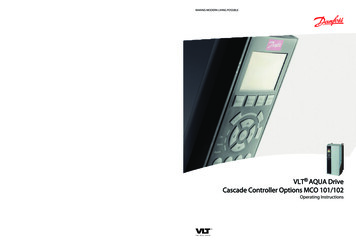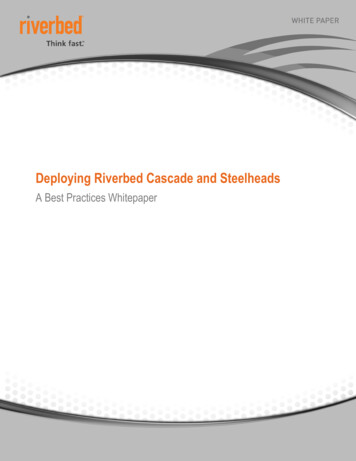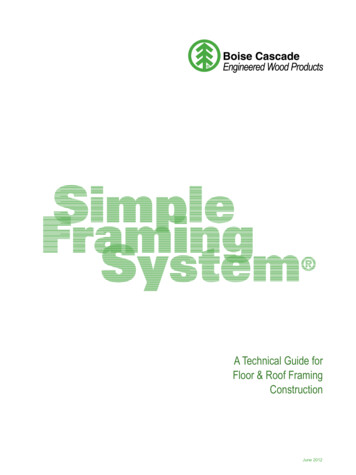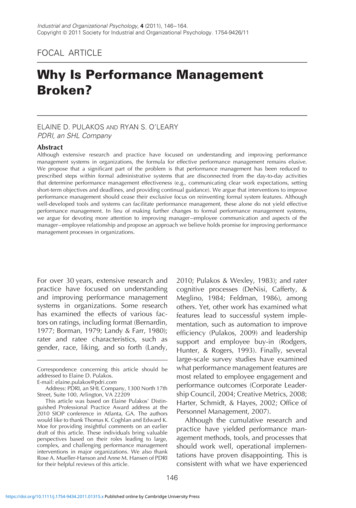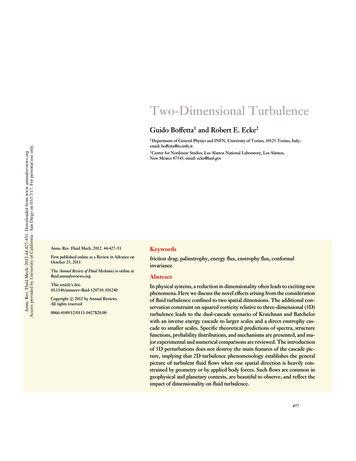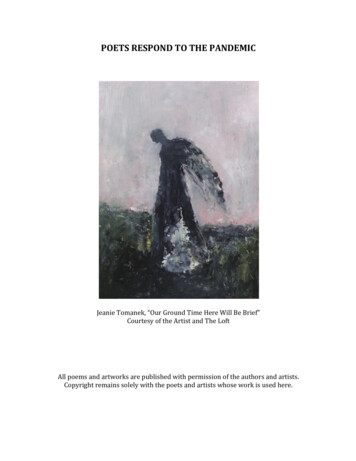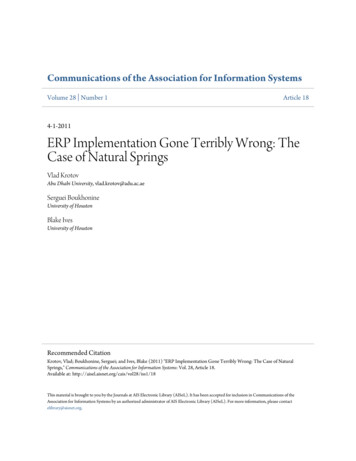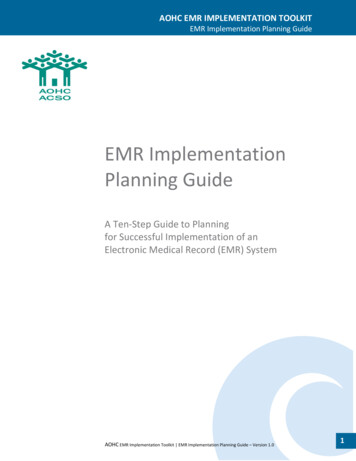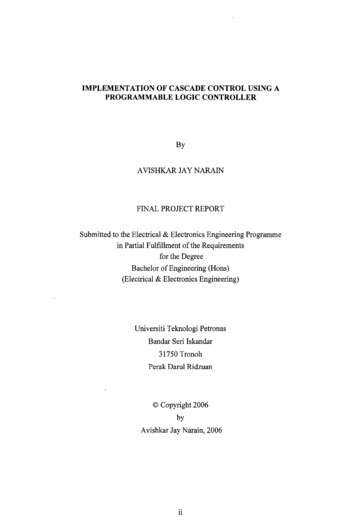
Transcription
IMPLEMENTATION OF CASCADE CONTROL USING APROGRAMMABLE LOGIC CONTROLLERByA VISHKAR JAY NARAINFINAL PROJECT REPORTSubmitted to the Electrical & Electronics Engineering Programmein Partial Fulfillment of the Requirementsfor the DegreeBachelor of Engineering (Hons)(Electrical & Electronics Engineering)Universiti Teknologi PetronasBandar Seri Iskandar31750 TronohPerak Darul Ridzuan Copyright 2006byAvishkar Jay Narain, 200611
CERTIFICATION OF APPROVALIMPLEMENTATION OF CASCADE CONTROL USING APROGRAMMABLE LOGIC CONTROLLERbyAvishkar Jay NarainA project dissertation submitted to theElectrical & Electronics Engineering ProgrammeUniversiti Teknologi PETRONASin partial fulfillment of the requirement for theBachelor of Engineering (Hons)(Electrical & Electronics Engineering)Approved:Dr. Nordin SaadProject SupervisorUNIVERSITI TEKNOLOGI PETRONASTRONOH, PERAKJune 2006lll
CERTIFICATION OF ORIGINALITYThis is to certify that I am responsible for the work submitted in this project, that theoriginal work is my own except as specified in the references and acknowledgements,and that the original work contained herein have not been undertaken or done byunspecified sources or persons.Avishkar Jay NarainIV
ABSTRACTThe aim of the project is to implement cascade control using a ProgrammableLogic Controller (PLC). The PLC module has been successfully used forON/OFF control in sequential processes. However in this project the PLC has tobe configured to accept and monitor a variable input and to supply a variableoutput (4mA to 20mA) signal in-order to control a final element (e.g. controlvalve). The significance of this project is to make a comparison between a PLCand a distributed control system (DCS) in terms of controllability and systemsimplicity. The project requires familiarization in the field of plant processcontrol and instrumentation since it involves the design and implementation of acascade loop. The cascade controller has been designed to control the level of aliquid in a distillation tower. Familiarization with the PLC hardware and softwareis another important aspect of the project and took up the bulk of the project time.The final result of the project shows that the PLC is a versatile controller that isable to perform PID control effectively with a relatively simple system. The PLCPID control system is flexible therefore it can be configured to implement anytype of control loop e.g. Cascade control.v
ACKNOWLEDGEMENTSFirst and foremost I would like to thank Sathya Sai Baba for enabling me to completethis project successfully. I would like to thank my supervisor Dr. Nordin Saad for theguidance and advice he has given me throughout the duration of the project. I wouldalso like to thank Mr. Azhar the technician in charge of the PLC lab for his adviceand providing me with the equipment and operating manuals I needed to complete theproject. I would also like to thank my girl friend, Avisha Sahadeo for supporting meand helping me to understand the process part of my project. Also thanks to myfamily in South Africa who always urges me to do the best I can in every task that Iundertake.Vl
TABLE OF CONTENTSABSTRACT.vACKNOWLEDGEMENTS.viLIST OF TABLESX.LIST OF FIGURES .XICHAPTER 1: INTRODUCTION11.1 BACKGROUND OF STUDY21.2 PROBLEM STATEMENT21.2.1 PROBLEM IDENTIFICATION21.2.2 SIGNIFICANCE OF PROJECT21.2.2.1 Comparison between PLC and DCS systems21.3 OBJECTIVE AND SCOPE OF STUDY41.3.1 THE RELEVANCY OF PROJECT41.3.2 FEASIBILITY OF PROJECT WITHIN SCOPE AND TiME FRAME4CHAPTER 2: LITERATURE REVIEW52.1 AUTOMATIC PROCESS CONTROL52.2 CASCADE CONTROL .52.2.1 ZIEGLER-NICHOLS TUNING METHOD62.2.1.1 Oscillation Method62.2.1.2 Open Loop Method72.2.2 CASCADE DESIGN CRITERIA82.2.3 CASCADE PERFORMANCE82.2.4 APPLICATIONS OF CASCADE CONTROL92.2.4.1 Heat Exchanger .92.2.4.2 Distillation Tower10vii
2.3 PROPORTIONAL- INTEGRAL-DERIVATIVE (PID) CONTROL112.3.1 PID CASCADE CONTROL112.3.1.1 The Controller .112.3 .1.2 Proportional Mode (P)122. 3. 1.3 Integral Mode (I)122.3.1.4 Derivative Mode (Rate) (D)132.3.1.5 Two Mode Control142.3.1.6 Three Mode Control14CHAPTER 3: METHODOLOGY/PROJECT WORK153,1 PROCEDURE IDENTIFICATION153.2 TOOLS REQUIRED163.3 TIMING DIAGRAM- INITIAL TASK163.3.1 LADDER PROGRAM OF A SIMPLE BINARY SYSTEM183.3.1.1 Methodology183.3.1.2 Timing Diagram.193.3.1.3 Logical Equations203.3 .1.4 Ladder Diagram .213.4 SOFTWARE IMPLEMENTATION223.4.1 ADDRESSING223.4.2 TEST ANALOG I/O's253.4.3 THE PID EXPANSION INSTRUCTION263.4.4 CASCADE CONTROL- LADDER PROGRAM293.5 HARDWARE IMPLEMENTATION3.5.1 OMRON PLC3333.3.5.1.1 CQMlH Analogue Input/Output Module3.5.2 INSTRUMENTATION3335vm
3.5.2.1 Control Valve353.5.2.2 Transmitters373.5.3 HARDWARE SETUP393.5.4 IMPLEMENTATION OF SINGLE LOOPCONTROL ON A PHYSICAL PLANTCHAPTER 4: RESULTS & DISCUSSION40424.1 EFFECT OF PROPORTIONAL BAND (PB) ON THE CONTROL SYSTEM424.2 DISCUSSION46.4.2.1 DISCUSSION OF PID TUNING464.2.2 IMPLEMENTATION OF SINGLE LOOP CONTROL ON APHYSICAL PLANT474.2.3CASCADE SYSTEM47CHAPTER 5: CONCLUSION50CHAPTER 6: RECOMMENDA'fiONS51REFERENCES52APPENDICES54APPENDIX A: P&ID drawing of a Cascade control system55APPENDIX B: Loop Diagram56ix
LIST OF TABLESTable 1.1:Comparison ofDCS and PLC functionalityTable 3.1:IR data areas specificationTable 3.2:Analog 1/0 addressesTable 3.3:DM memory assignmentsTable 3.4:DM 6611 settingsTable 3.5:Advanced PID settingsTable 3.6:Flag status tableTable 3.7:Pin Arrangement of Connectors CNlTable 3.8:Pin Arrangement of Connectors CN2Table 4.1:Table of controller input and output values for PB 20%Table 4.2:Table of controller input and output values for PB 50%Table 4.3:Table of controller input and output values for PB 80%X
LIST OF FIGURESFigure 2.1:Block Diagram representing Cascade ControlFigure 2.2: Cascade control of effluent temperature via steam flow controlFigure 2.3: Example Of Cascade Control Controlling the level of process fluid in aDistillation towerFigure 2.4: Proportional Action (Step Change)Figure 2.5: Integral ActionFigure 2.6: Derivative ActionFigure 2. 7: PI ControlFigure 2.8: PID ControlFigure 3.1:Project configuration (Level Control of a Distillation Tower)Figure 3.2:Simple Binary Timing Diagram of Cascade ControlFigure 3.3:Timing Diagram showing Timers & Holding RelaysFigure 3.4:Ladder Program of Cascade ControlFigure 3.5:Ladder Program testing analog I/O'sFigure 3.6:Bit sequence entered into address DM 6611Figure 3. 7:Ladder Diagram of a Single PID control LoopFigure 3.8:Ladder Diagram (Cascade Control)Figure 3.9:Cascade control ladder diagram with HIGH and LOW alarmsFigure 3.10: 'Area range control' Ladder SymbolFigure 3.11: Analogue Input/Output Module configurationFigure 3.12: Internal structure of a Globe valve (bottom half)Figure 3.13: Connections between the PLC and field instrumentationFigure 3.14: P&ID of an open tank systemFigure 3.15: Ladder program oflevel control systemFigure 4.1:Graph of% valve opening V s controller input signalFigure 4.2:Graph of% valve opening V s controller input signalXI
Figure 4.3:Graph of% valve opening Vs controller input signalFigure 4.4:Project configuration (Level Control of a Distillation Tower)xn
CHAPTER!INTRODUCTION1.1 BACKGROUND OF STUDYCascade Control has been implemented in many Plant Process Control applications.This type of control is usually implemented using a distributed control system (DCS)or a field bus system, which are both complex and expensive to implement andmaintain. Cascade control can improve control system performance over single-loopcontrol whenever either: Disturbances affect a measurable intermediate or secondary process output thatdirectly affects the primary process output that we wish to control The gain of the secondary process, including the actuator, is nonlinear.In the first case, a cascade control system can limit the effect of the disturbancesentering the secondary variable on the primary output [4]. In the second case, acascade control system can limit the effect of actuator or secondary process gainvariations on the control system performance [4]. This type of control thereforeincreases control over specific processes, which means a better refining of chemicalsin the plant. The problem is that on a small scale it is not economical to implementCascade control using a complex DCS or field bus control system. This type ofcontrol can be implemented with PLC control, which is simpler and moreeconomical to implement.I
1.2 PROBLEM STATEMENT1.2.1 PROBLEM lDENTIFICA TIONThe aim of this project is to utilize the OMRON PLC analogue module to monitorand control a process loop connected in cascade arrangement. The process loopconsists of loose field instrumentation (e.g. SMART Transmitters, Control Valves).The project simulates cascade level control of a typical distillation tower (refer tofigure 2.3) in a refinery. This type of cascade control is described in detail in section2.2 of this report.In a typical control system a variable analogue signal (4mA to 20mA) is used toindicate the value of the process variable and to manipulate the final element aftercontrol has taken place. The PLC module is usually used for ON/OFF or BINARYcontrol therefore the biggest challenge to overcome in this project is to configure theOMRON PLC to accept a variable input and to output a variable 4mA to 20mAsignal so that it can control the final element (e.g. control valve).1.2.2 SIGNIFICANCE OF PROJECTCascade Control is usually implemented in a refinery using distributed or field buscontrol systems, which are complkated and expensive. The PLC system is a reliable,simpler and inexpensive system therefore more economical to use in small-scaleplants.1.2.2.1 Comparison between PLC and DCS systemsThe programmable logic controller (PLC) is generally used in machine control whilethe distributed control system (DCS) dominates process control applications [7].With technology today the two systems can be used in either of the two applications,since the functional lines between them do not differ entirely [7].2
Table 1.1: comparison of DCS and PLC functionality [7]DCS functionalityIPLC functionalityAble to performed hundreds of analog The PLC is fast and most can run anmeasurements and control a number of input-compute-outputmmillisecondsanalog outputs2cycleHas a centralized configuration from which The PLC is fast and most can run anthe operator in the control room can monitorinput-compute-outputand make changes to the control system.milliseconds3 Requires an operatorinterfaceandaA PLC can runcyclemin a stand-alonecomplex communications network, so it can configuration there is no need for asend alarms, messages, and trend updates4complex networkUse operating systems that allow multi- The PLC is a simple, rugged computertasking (i.e. download, run applications and that has minimal peripherals and simpleperform real-time control functions).operating systems, this increases theirreliabilityAn important difference between the DCS and PLC is how vendors market them.DCS vendors typically sell a complete working, integrated system, which is fullytested, and tailor made for the client [7]. They offer services such as training,installation, field service, and integration with existing Information Technology (IT)systems. A DCS vendor provides a server, a LAN with PCs for office automation,networking support and integration of other applications and systems [7]. The PLChowever is usually sold as a single device therefore it is more of a self-implementedsystem since it is usually simpler to setup and execute [7].3
1.3 OBJECTIVE AND SCOPE OF STUDY1.3.1THE RELEVANCY OF PROJECTThe project requires to a certain extent, knowledge in plant process control andinstrumentation since it involves the design and implementation of a cascade loop,which consists of loose instrumentation. The purpose of the cascade loop is tocontrol the level of the liquid in a distillation tower. Cascade controlISafundamental control configuration used in varied applications in Refineries.Therefore implementing this type of control using a simpler system and addedcontrollability will be relevant in future control systems.1.3.2 FEASIBILITY OF PROJECT WITHIN SCOPE AND TIME FRAMEThe project is anticipated to be feasible within the scope and time frame available.The necessary controller modules and the instruments needed to implement thecontrol system are available. The main obstacle of the project could be if the PLCmodule is not able to input and output variable signals, however this may be overcome by using external circuitry to fulfill this requirement.The project requires the familiarization of equipment and software, theimplementation of the hardware and software aspects of the cascade control system,and performing several "what-ifs" to simulate several situations in the plantenvironment.4
CHAPTER2LITERATURE REVIEW2.1 AUTOMATIC PROCESS CONTROLAutomatic process control is defined as a system in which, without humanintervention, the value of a process variable is compared with a given value (setpoint) and correction action is taken whenever these two values differ [4]. Beforeautomatic control was developed process control was done manually. Operators wereresponsible for keeping the process stable by adjusting the process variables (e.g.temperature, pressure etc.). Using manual control meant that process control wasinaccurate and unsafe. Automatic process control has lowered labor costs, virtuallyeliminated human errors, improved process quality and provided greater safety inoperation [4]. One of the configurations used in automatic process control is referredto as cascade control, which is described below.2.2 CASCADE CONTROLCascade control requires the output of one controller to act as the set point for thesecond controller [8]. In this form of control each controller has its own measuredvariable with only the primary controller having an independent set point and onlythe secondary controller providing an output to the process [8]. This type of controlis needed in situations where a long time lag exists between the manipulated variable(e.g. flow of the process fluid) and its effect on the measured variable (e.g. level ofthe process fluid) [8].5
PlantrlPrimarySt:. cnndary('Ontrolkrconl'n,llerlC"J C', rA(I.IJ"IG1lIJ.IG2I'IInner loopOutc:r loopFigure 2.1: Block Diagram representing Cascade Control [8]2.2.1 ZIEGLER-NICHOLS TUNING METHODThe Ziegler-Nichols tuning method uses a procedure, which involves measuring theresponse of a system to a change in set point and then performing calculations todetermine the values of P, I and D [5]. This tuning method results in an overshootresponse, which stabilizes. The advantage of Ziegler-Nichols tuning is that all threetuning constants kp, Td and T; can be calculated therefore no trial and error is neededto achieve initial tuning [5]. There are two methods to calculate the PID parametersusing Ziegler-Nichols method.2.2.1.1 Oscillation MethodThis method requires the system to be a closed loop. Two parameters ultimate gainku and ultimate period T u have to be determined in-order to calculate kp, T d and T;.At the beginning all PID parameters should be set to zero, then the value of kpshould be increased to the minimum value that will cause the system to oscillate [5].The oscillation should be a sustained oscillation. When there is a sustainedoscillation the value ofkp used is the ultimate gain of the controller ku [5].kp ku6
The period of the oscillation is the ultimate period of the controller T u [5]. Once theku and Tu are values are found the controller parameters can be calculated using thefollowing formulae:Proportional GainIntegral Time Derivative Timekp 0.6 kuT; 0.5 Tu T d 0.125 T u2.2.1.2 Open Loop MethodThis method requires one to determine the dead time (8), rise time ('r) and processgain (kc), these parameters will be used to calculate the PID parameters [5]. Thesystem should be in open-loop unity gain configuration i.e. there should be no feedback loop, k J should be one and T; and Td should not be used. When the system issetup properly a known step change should be applied to the system. When this stepchange is applied the graph of the process variable PV should be recorded withrespect to time [5]. From the graph one can calculate the dead time, rise time andgain ofthe process. Once these parameters are calculated the values of kp, T; and Tctcan be calculated using the following formulae [5]:kp 1.5 't' /( kct8)T; 2.58Td o.4 eThese values will provide an initial stable system, which may need fine tuningdepending on the requirements of the process system being controlled.7
2.2.2 CASCADE DESIGN CRITERIAWhen designing and implementing a cascade control system there are certain designcriteria that need to be considered. These criteria ensure that cascade control isdesigned properly and used where appropriate. Cascade control should only be usedwhen single loop control does not provide efficient control [4]. Before designing acascade control system the designer must ensure that there is an acceptablemeasured secondary variable that is available to be used in the system [6]. Thesecondary variable has to satisfy three criteria, which are listed below: It must indicate the occurrence of an important disturbance. The secondary variable must be influenced by the manipulated variable i.e. acausal relationship must exist between the variables. The dynamics between the final element and the secondary must be much fasterthan the dynamics between the secondary variable and the primary variable [4].These criteria ensure that the secondary loop will have a significant effect on thecontrolled variable, which will o :cur whenever an important disturbance occurs [4].The differences in dynamics ensure that a disturbance is attenuated before it affectsthe primary variable.2.2.3 CASCADE PERFORMANCEThe primary objective in cascade control is to divide an otherwise difficult tocontrol process into two portions, whereby a secondary control loop is formedaround a major disturbances thus leaving only minor disturbances to be controlledby the primary controller [4].8
There are several advantages gained by using cascade control these are listed below[4]: Better control of the primary variable Primary variable less affected by disturbances Faster recovery from disturbances Reduce the effective magnitude of a time-lag Improve dynamic performance2.2.4 APPLICATIONS OF CASCADE CONTROL2.2.4.1 Heat ExchangerIn a heat exchanger a steam flow may heat the product even after the flow has beenreduced therefore it will be difficult to achieve the set point temperature[9]. Cascadecontrol is used in the control of a heat exchanger (Figure 2.2). In this applicationtwo loops exist which are described below [9]: The Primary Loop: consists of the primary temperature controller, whichreceives a signal from a (PV) temperature transmitter that measures thetemperature at the outlet of the heat exchanger. The output of the primarycontroller is connected to the input ofthe secondary flow controller [9]. The Secondary Loop: The Secondary controller is a flow controller, whichreceives a signal from a (PV) flow transmitter that measures the steam flowrate into the exchanger. The output of the flow controller is connected to acontrol valve that directly controls the flow rate of the steam into the heatexchanger [9].The secondary loop ensures that the steam flow variations are corrected immediatelybefore the hot-water temperature is affected. Since the output of the Primary9
controller is the set point of the secondary controller temperature set point variationsat the output will be corrected [9].lSteamSecondaryController (Flow)Master Controller(Temperature Controller)- .tt --- .- .SctpointFeed. - EffluentFigure 2.2 Cascade control of effluent temperature via steam flow control [9]2.2.4.2 Distillation TowerAnother application where Cascade Control is implemented is level control of adrum or in this case (Figure 2.3) a distillation tower [1]. In this instance cascadecontrol is used so that sudden variations in the process fluids level do not have animmediate effect on the flow of the process fluid out of the distillation towertherefore the flow of the process fluid is not erratic [I]. This is important since inmost chemical processes the flow rate is required to be constant. In figure 2.3 belowcascade control is used to control the level of the process fluid and the flow rate outof the distillation tower. In the diagram below (figure 2.3) the level control loop actsas the master controller (primary loop) and the flow control loop acts as the slavecontroller (secondary loop) [I]. The level transmitter feeds signal to level controller(LIC), and the output from the level controller is used as the set point for the flowcontroller (FIC). The output from the flow controller is used to control the openingof valve (FV), which regulates the flow rate of process fluid from the distillationtower. Value from level and flow loop tuning is used in cascade control to ensure theoutput of the controller was tuned by gradually adjusting the manipulated variable sothat the level of the tank matches the set point [I].10
DistillationTowerI ··ll!f' ··I,,. .t.ISecondary: FlowController (B)IPrimary: LevelController (A) -Figure 2.3: Example of cascade control controlling the levelof process fluid in a distillation tower2.3 PROPORTIONAL- INTEGRAL-DERIVATIVE (PID) CONTROL2.3. I PID CASCADE CONTROL2.3.1.1 The ControllerThe critical inputs to a continuous process controller are the process variable (PV)and the set point (SP). During operation, a controller measures the PV, which is theactual value of the variable (e.g. temperature) at any given time, and compares it tothe SP, which is the desired value [4]. It then makes the adjustments needed toreduce the error between the two until the process is under proper control. When PV SP, the error is zero and the process is balanced [4]. To do this, the controllerII
generates an output signal and sends it to the final control element. The controller isable to operate in 3 basic modes or combination of these modes in order to correctthe offset between the PV and the SP [4]. These modes are described below in moredetail:2.3.1.2 Proportional Mode (P)A controller operating in the proportional mode produces a given change in theoutput for each unit of difference between the PV and SP. In this action there is alinear relation between the value of the actual measurement and the valve positioni.e. it is the action that gives a valve movement proportional to the pen movementrelative to the set point [4].Figure 2.4: Proportional Action (Step Change)%Proportional Band (PB)Is the percentage of full scale reading through which the actual measurement mustchange to produce full stroke travel of the control valve. The wider the percentagePB the slower the controller reacts to changes in the PV. Therefore a widepercentage PB means that the controller has a small gain value. As the percentagePB is narrowed the reaction of the controller becomes faster. At 0% PB a controlleroperates as an ON/OFF controller [4].GAIN IOO PB2.3.1.3 Integral Mode (I)This mode eliminates the offset between the set point and the actual value. As longas there is any difference between PV and SP the integral mode or reset acts toadjust the controller output continuously until the offset is reduced to zero.12
Controllers often label the reset setting as integral time instead of reset. It is thesame adjustment expressed in repeats per minute, while integral time is expressed inminutes per repeat, the inverse of reset [4].RESET 1 Integral Time(repeats per min)INTERGRAL TIME 1 Reset(min per repeat)Figure 2.5: Integral Action2.3.1.4 Derivative Mode (Rate) (D)The derivative mode or rate action provides additional controller output wheneverthe process error is changing. The rate of change of the error determines the amountof extra output supplied by the derivative, or rate action. The faster the PV changesrelative to the SP, the more output is supplied by the controller. Rate time isexpressed in minutes. The rate mode causes a quick response to a quick change andalmost no response to a slow change [4].---'"" --Figure 2.6: Derivative Action13
2.3.1.5 Two Mode ControlProportional Integral Mode (PI) mode is used when SP and PV change often. It isused to eliminate Offset.Figure 2.7: PI ControlProportional Derivative Control (PD) mode is used when large sudden changes inSP, PV or load occur. This mode corrects rapidly changing errors and minimizesovershoot.2.3.1.6 Three Mode ControlIn this mode Proportional Integral Derivative Control (PID) are used. This modeis used where large, sudden changes in PV, SP or load occur. This mode correctsrapidly changing errors, eliminates offset and minimizes overshoot.o: . ,. .Figure 2.8: PID Control14
CHAPTER3METHODOLOGY/PROJECT WORK3.1 PROCEDURE IDENTIFICATIONIn order to successfully execute this project an effective procedure has beenidentified and followed. This procedure as outlined in the flow chart has emanatedfrom this study.ISTARTI"(7 ILearn OMRON PLCHardware/ResearchILearn Software: CXProl!fammer' 7Investigate PracticalImolementationSuggest Solution & Implement SimpleControl LoopTest Control Loop & VerityFunctionality of Loop"(7IFND15I
3.2 TOOLS REQUIREDThere are several tools that are essential to the completion these include: OMRON PLC: The OMRON PLC is a programmable logic controller, whichwill be programmed to implement cascade control. CX Programming Software: This is the software used to program the PLC.The software uses ladder logic to display the logic program. Control Valves: Is the final element instrument which will be manipulated bythe secondary controller i.e. it will control the flow out of the distillation tower. Controllers: This piece of equipment will be used implement PID and store theset points of the process variables being controlled.3.3 TIMING DIAGRAM- INITIAL TASKThe diagram below (figure 3.1) shows the actual cascade control system that thisproject will be mro d tionTowerSecondary: Flow---.2,.---------, -·,i- !- 4.,/.I' IPrimary: LevelController (A)'""' I Controller (B)IIFigure 3.1: Project configuration (level control of a distillation tower)16
As one can see the cascade control system is controlling the level of the process fluidin the distillation tower by regulating the flow rate of the liquid out of the tower. Thesteps of control are identified below: The level transmitter (LT) is the INPUT for the primary controller(controller A). Controller A OUTPUT determines the SET-POINT (SP) for the secondarycontroller (controller B). The flow transmitter (FT) is the INPUT for controller B. The OUTPUT of controller B controls the flow valve (FV) i.e. this valvecan either increase or decrease the flow rate out of the Tower.The timing diagram represents two situations namely: Level measurement is above SP (i.e. L T has a positive pulse) Level measurement is below SP (i.e. LT has a negative pulse)ii "i'I:i----- , ·- ----1-.,.,;.·-J.,.J--------i--1-LT!I! j!·-· --------H-H----jlj'lI- :.'. ''r-- - - - 1.---,l. .C.L -----J-\- --1'--·-· !'""l''FTFigure 3.2: Simple Binary Timing Diagram of Cascade Control17
The two controllers each have a SP input, a measured variable input (MV) and acontrolled output signal: Controller A-Set-point is specified manually and does not change-MV input signal is received from the Level transmitter LT-Output signal sets the set-point of controller BController B-SP is determined by Controller A output signal-MV input is received from the Flow Transmitter-Output signal controls the Flow Valve3.3.1 LADDER PROGRAM OF A SIMPLE BINARY SYSTEM3.3.1.1 MethodologyIn order to the get an optimized ladder diagram (program) one must follow 3 basicsteps these are listed below:I. Create a detailed Timing Diagram which includes all the components that effectthe outputs in the application namely:- Internal Outputs (Holding Relays)- Switches- Timers (internal timers)In reality this is the crucial step that involves careful study of the sequences andto establish the objective of the control.II. Develop a logical equation of each component of the timing diagram e.g. Timer l.The general equation is shown below: ut (set latch) . rese III. Using the equations in step 2 construct a ladder diagram.18
3.3 .1.2 Timing DiagramLTHISLTLLTHRTX/i""HRTYTIM Itiml2sITIM2Itim2CAII !If---t--r--- -----· ·····--···· ···-· --- ----'- - -- --- -- ,--- .----1--t-i ,. . . . . . . l,TIM3. . . . . . II:.,1! - -----------1···-·,[·····- -·-··-··-·,,II:·r- - --lf----l--!----- -·-·- ·····--·--···· ----- ·- - - -- -- --f---1--'···- -·· ·1 ·····-·--r·········-···1tim34s -I-1'ITIM4tim4CBTIMStimS6sIITIM6tim6FTIIIFigure 3.3: Timiug Diagram showing Timers & Holding Relays19I
Figure 3.3 is the timing diagram that correlates to the control sequences of thecascade controller that has been established.3.3.1.3 Logical Equations1.LT (SLTH LT) . SL TL2.HRTx (SLTH HRTx). SLTL3.HRTy (SLTL HRTy). SLTH4.TIM! HRTx5.TIM2 HRTy6.CA (timl CA) . tim27.TIM3 HRTx8.TIM4 HRTy9.CB (tim3 CB) . tim410. TIM5 HRTx11. TIM6 HRTy12. FT (tim5 FT) . tim5Where,SLTL Switch Level Transmitter LowSLTH Switch Level Transmitter HighHRTx HRTy Holding Relays x andy (internal outputs)TIM timertim signifies when the timer is SETOnce the logical equations have been defined the next step is to transform theequations into its ladder diagram. Figure 3.4 shows the ladder logic diagram that hasevolved from the process.20
3.3.1.4 Ladder Diagram0,0 1'"0.02sl.:L LT'A'.HIHx -HRTyTIMTimer001Timer numb-er010.02'HSL1 L11JX2L0 1SLTH2t1HRTX--4#20Set valueTIMTimer
The programmable logic controller (PLC) is generally used in machine control while the distributed control system (DCS) dominates process control applications [7]. With technology today the two systems can be used in either of the two applications, since the functional lines between them do not differ entirely [7]. .
